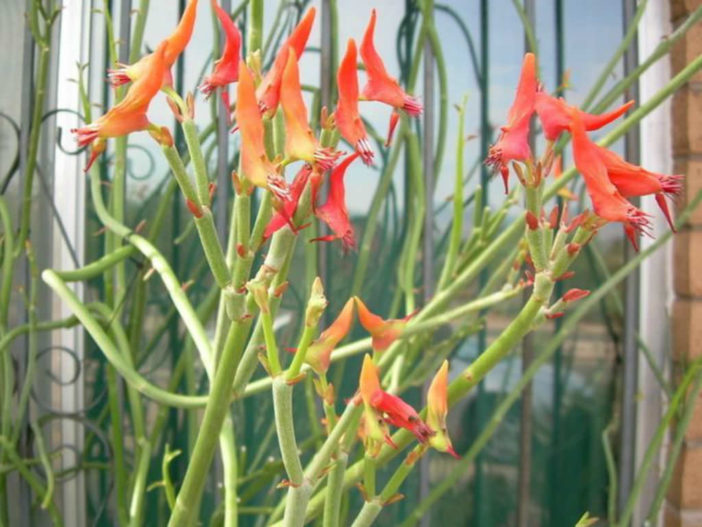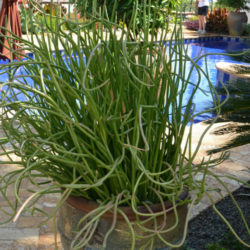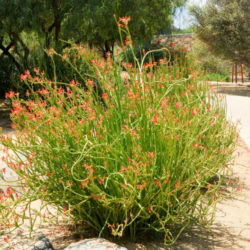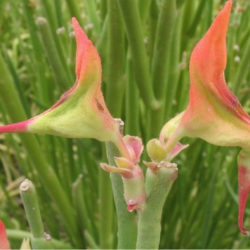Scientific Name
Euphorbia lomelii V.W.Steinm.
Common Name(s)
Lady's Slippers, Slipper Plant
Synonym(s)
Hexadenia macrocarpa, Pedilanthus macrocarpus, Tithymaloides macrocarpa, Tithymalus macrocarpus
Scientific Classification
Family: Euphorbiaceae
Subfamily: Euphorbioideae
Tribe: Euphorbieae
Subtribe: Euphorbiinae
Genus: Euphorbia
Description
Euphorbia lomelii, formerly known as Pedilanthus macrocarpus, is an unusual slow-growing succulent with slender, sometimes branched, lime-green stems that are usually leafless or with tiny inconspicuous leaves. It spreads slowly outwards, with new stems emerging from below ground to form tight, up to 3 feet (90 cm) wide clumps. The stems grow up to 6 feet (1.8 m) tall and 0.5 inches (1.3 cm) in diameter, at first erect, later arching or bending outwards under their weight. They are tapered like a candle near the tips and covered by a waxy substance called "candelilla," meaning "little candle," giving them a white sheen.
The unusual, red, peach to yellow, slipper-shaped flower-like structures (cyathia) appear in clusters at the tips of the stems in mid-summer into fall. The red, oblong fruits develop from female flowers and are visible in late fall and winter.
Origin
Euphorbia lomelii is native to Mexico.

Hardiness
USDA hardiness zone 9a to 11b: from 20 °F (−6.7 °C) to 50 °F (+10 °C).
How to Grow and Care
Euphorbias are very easy to care for. They require a little pampering to become established, but once they are, they are self-sufficient. More die from too much care and watering than from neglect. Euphorbias need well-draining soil and lots of sunlight. They are not particular about soil pH but cannot tolerate wet soil. Unlike most succulents, Euphorbia does not handle long periods of drought well. It may need weekly watering during the summer. Water whenever the soil is dry several inches below the surface. Water deeply, but don't let them sit in wet soil, which can cause root rot. Add some organic matter or fertilizer to the planting hole. If you are growing them in containers or your soil is poor, feed them with a half-strength fertilizer monthly.
Euphorbia can be grown from seed, but they can be difficult to germinate (or even find). It is usually propagated by cuttings. This can be tricky because of the exuding sap. Rooting hormone is recommended with Euphorbias. They tend to grow problem-free, but there are a few pests and diseases to be alert for.
See more at How to Grow and Care for Euphorbia.
Links
- Back to genus Euphorbia
- Succupedia: Browse succulents by Scientific Name, Common Name, Genus, Family, USDA Hardiness Zone, Origin, or cacti by Genus
Photo Gallery
Click on a photo to see a larger version.


